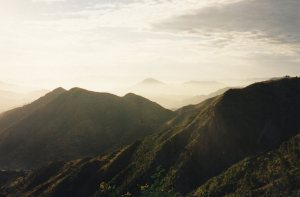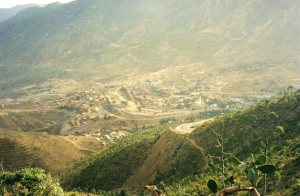The journey down to Massawa was one of the most fantastic drives you can ever imagine but like many epic trips, it starts in a very ordinary way. We traversed the southern suburbs of Asmara, through the palm fringed streets up to the lorry park and market place, then turned right up by the Coptic Cathedral and headed up a long steady rise to the edge of the city. We burst out into a semi-countryside of industrial units, the occasional high-status house and pine woods. The road wound gently through this rocky, wooded landscape, like a dry version of the West Coast of Scotland. The driver never changed gear, he swung around the corners freely as if he had done it many times before. I hoped he had and knew where all the bends were in the journey that followed.
On the front dashboard was a small digital display that had the temperature. Despite being at 15 degrees north, the temperature read 16 degrees C when we left Asmara. It was still early in the morning, and because of the height, the temperature in the city rarely rose above 26.
We reached the edge of the escarpment. Here a small restaurant hung precariously off the side of the road, and I saw the most stunning view. The mist rose out of several ridged mountains, the valley bottoms shrouded from view. Out to the east, somewhere, lay the Red Sea. Not only out to the east, but also down, down, down.
We did not pause, but the driver started the long descent, the road hugging tight revetments. Little villages occasionally clung to the edges of the roadside, barely room for a small two roomed hut before a sheer scree dropped a thousand feet into the abyss. The road started by hugging the south side of one of these mountainous revetments, the disused bed of the railway track from Asmara to the coast also clung at a height above us,. Occasionally, the towers of the third form of transport between the two towns was visible. This was the aerial ropeway that was the easiest way for goods to be transported up from the port city to the capital. It had been built by the Italians during their occupation and it was disabled during World War II but the stone pillars still mark the route of this ingenious transportation.
The three routes crossed each several times, the railway, often called the steel snake for obvious reasons, leaping overhead on a yellow stone viaduct before plunging deep into a rock tunnel, emerging a hundred feet lower in the next valley.
The road swung left and right almost rhythmically down, rarely changing its gradient. It has obviously been a deceptive creature at times, the swings of the steering wheel sometimes not enough when the road takes an unexpected turn, the trail of rubber, some burnt vegetation and the wreck of a lorry or bus half way down the mountainside proved that point. Going down, the taxi passed several buses, timing his overtaking just at the most unnerving part of a corner, occasionally nearly missing his timing and swerving back behind the bus as a car powered up the hill in the other direction.
Large numbers of lorries plough their way up the hill towards Asmara, some of them reaching the dizzy speeds of 10 miles an hour. Great plumes of black smoke betray the energy that is put into hauling these huge lorries up to the top of the hill.
On we went downwards. I got an impression of how precariously we clung to this arrete that we were going down, when we came to a knife edge where the railway and road share the same thin piece of land. A few houses clustered on this edge, and then suddenly we crossed from one valley to the other, and now the mountain was on the right and we were descending into a slightly more lush area. From this viewpoint we could trace the course of both the old railway and the road down the valley a further twenty kilometres. A couple of camels were munching the acacia bushes next to the roadside. I had to stop to take a photograph – these were the first “wild” camels I had ever seen. I got back in the car and looked at the thermometer gauge on the dashboard, it now read 28 degrees C.
We dropped down to the town of Nefasit where we took a left turn to the north and followed the road that we’d seen from the top of the arrete. The land became slightly less spectacular, there were still high hills above us but we were over half way down and the drops below were less severe. The land was a mixture of rocky outcrops and loose stones with a thin green veneer. This region is quite well known for its relative lushness. The tops of the clouds I had seen in Asmara covered this region regularly and gave it much more moisture than the rest of the country. I had seen this green patch on a satellite image I had of the region; the only green spot on a sea of brown.
Every five to ten minutes, I noticed that the thermometer had risen by another degree, it was now over 30. I realised that the taxi driver was quite uncomfortable. I suppose wearing a black leather jacket and black trousers was absorbing much of this energy. He shifted uncomfortably in his seat. Eventually, he eased himself half out of his jacket, it resting below his shoulders. To me this was even more uncomfortable, but he was not sacrificing his stylish garb completely.








